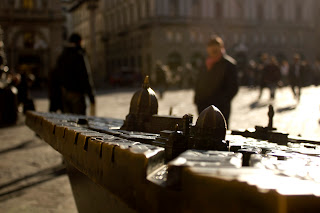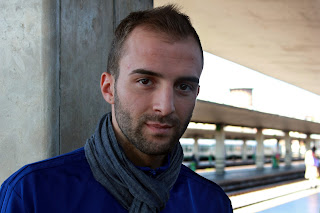 |
Night at the Piazza Il Duomo in Ortigia.
Wrapped up in cannolis, handcrafted in almonds, and ground up in granita is Sicily. |
My first experience of this Sicilian culture: the airport. And not just for arrivals and departures. Waiting for a delayed plane in Italy is like watching something grow. Always that question in the back of your mind: is this a waste of time? So we waited, wandering around, thoroughly scouring the half dozen stores and wondering, “Where is Sicily?”
Once released, we drove an hour from Cantania to Siracusa. Hotel Posta was situated on the water, part of the cultural center, Ortigia, a tiny island in the heart of Siracusa, connected to the mainland by several short bridges.
 |
Coast of Siracusa, standing on Ortigia.
|
The island was a perfect size. Within an hour, we could walk the coast in a full circle. The feel of the town reminded me of South Carolina. Charleston, specifically. Pinks and creams with palm trees and outdoor cafes. The architecture was spectacular. It lacked the finished quality of Florence and possessed that old, small-town charm that seems to have disappeared amidst the sea of tourists in Firenze.
Early in the morning, as Megan and I walked along the streets, we heard voices. Women, neighbors, lounging on their balconies, sipping coffee, talking back and forth, conversations floating across the streets and back. And then, an older woman, looked down at us, calling out “bella” and blowing us kisses. And I fell in love with Sicily and its people.
Our trip revolved around food and wine. Dinner is an enormous four-course affair, lasting for three hours, the plates of food endless and yet, unfortunately, all delicious. With the antipasti (appetizer, which seems to include the largest spread of food): breads of every kind soaked in olive oil and spices, sundried tomatoes, roasted peppers, olives, cheeses, salami, eggplant carpaccio, breaded shrimp, arancini di riso (fried mounds of rice stuffed with any combination possibility: formaggio, prosciutto, carne). And the list, as you can imagine, goes on.
And then, new plate, new silverware. The primi piatti (first course). Pasta galore. Red sauce. White sauce. Embedded with fish and meat and cheese and capers and pine nuts. And then, as you start to drift off into a food coma, they take your plates again, to reveal a third underneath. And a fresh set of silverware. The secondi piatti (second course) with contorni (side dishes). Platters of rosemary and olive oil baked potatoes and sausage and grilled pork.
And finally the last course, Dolce. A champagne glass filled with lemon granita. Or perhaps some fruit: persimmons, baby pears, grapes, apples. To, according to Sicilian chefs, cleanse the palette (for more food?!?....please no) and aid in digestion (after that meal, yes).
Saturday we spent most of the day at a ranch on mainland Sicily. Another four-course meal was followed by horseback riding through the rocky and wild terrain, skirting olive trees and cacti. My horse Sera, which means evening, was indeed as black as night. And like our guide, I don’t think she spoke English. In fact, I’m certain of it.
“Whooo….try.” Our guide pulled on the reins to show us how to stop.
Now I know how to stop a horse, but after trying every variation of “whoa,” “whoo,” and “whaa,” I was content to let the horse journey on its own, pausing at unfortunate moments to eat from the trees, pulling me violently through foliage as olive branches tore at my hair.
To be honest, I haven’t ridden a horse on my own without landing on the ground. And as I clutched my Canon Rebel to my side, I realized the mistake I had made. And then I reasoned with myself. No one will fall. I like horses. This is fun. I’m safe.
I could hear Megan behind me. Her horse was Stella, the stubborn one. Stern faced, she repeated over and over, “Andiamo, Stella. Andiamo!!!” While my horse was linguistically challenged, Megan’s horse was just deaf. She would stand there and not budge an inch.
 |
| Megan and Stella |
At one such moment, the guide started babbling in Italian, motioning to this hand and pointing to Megan, whose horse was resting with its head in a tree. I picked up two words “essere sposato” (to be married). And then it dawned on me; our gray haired and scraggly bearded horse guide was asking if Megan was married. I shook my head no, and he smiled, kicked his horse, and yelled “Andiamo!” (Sorry Megs. Just telling the truth.)
A couple minutes before we arrived back to the stables, Indos, the only male horse in the group, took off running, throwing his rider to the ground and spooking the other horses. For the first time during the ride, I nailed the “whoo” and managed to land my horse in yet another olive tree. Thankfully no injuries were sustained, and we spent the remaining afternoon sleeping in the sun and playing on a wooden seesaw.
The last day in Sicily, Sunday morning, was a tour of an archeological park in Siracusa. We hiked to the top of a Greek Amphitheatre. As you can see in the pictures, the theatre is in ruins, the stage missing, the seating scarce. The Spaniards, upon conquering the island, began to build fortifications. And instead of quarrying their own stone, recycled the limestone slabs from the theatre, removing the upper tiers of seating as well as the stage.
 |
| The Greek Amphitheatre. |
The Archeological Park in Siracusa is referred to as Latomia del Paradiso (Gardens of Paradise), and is truly beautiful, dressed in magnolias and oleanders. However, this ravishing garden grows out of the floor of the great quarry, the quarry that provided the limestone to build the Greek city of Siracusa. This “Garden of Paradise” was not always a parallel to the pearly gates. It was once a concentration camp, home to over 7000 Athenians, who, after losing the sea battle of 413 AD, were sent to the prison Latomie to quarry limestone (Latomie is Greek, meaning"to cut stone"). The 40 meter walls closed the prisoners of war off from the world, entombing them in a world of darkness and harsh physical labor. Many died from hunger and exhaustion, the quarry a mass grave. Those who survived for at least seven years were branded and sold as slaves.
Another site, Orecchio di Dionigi (Ear of Dionysius) is a masterful feat.
This cave, 23 meters high, was carved from the mountainside by the slave quarry workers.
Caravaggio, who visited Sicily in 1608, named the cave after Dionysius the tyrant.
The legend tells of a man who would sit high above the floor of the cave to eavesdrop on the slaves while they worked.
Due to the strange shape of the cave, even the quietest whisper is amplified as though it was a shout.
 |
| Ear of Dionysius. |
 |
| Sunset in Sicily |



















